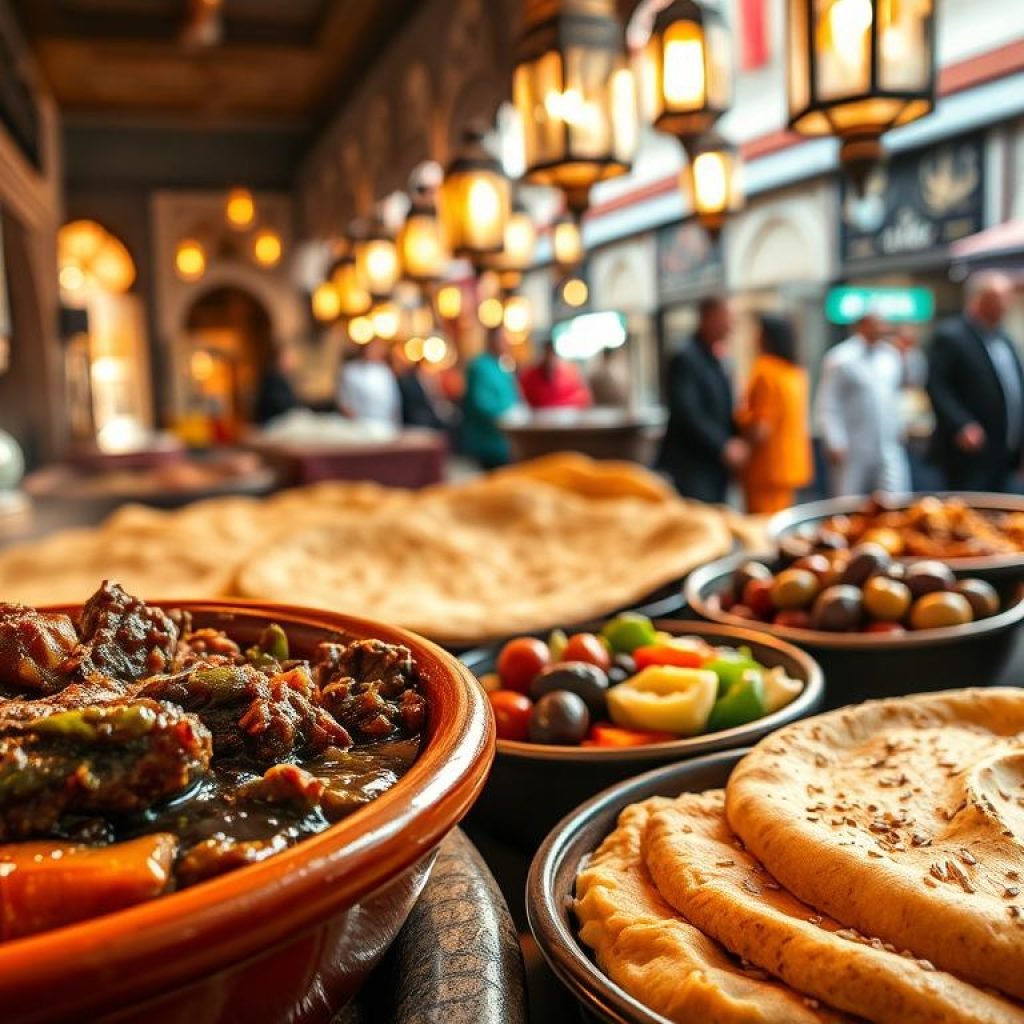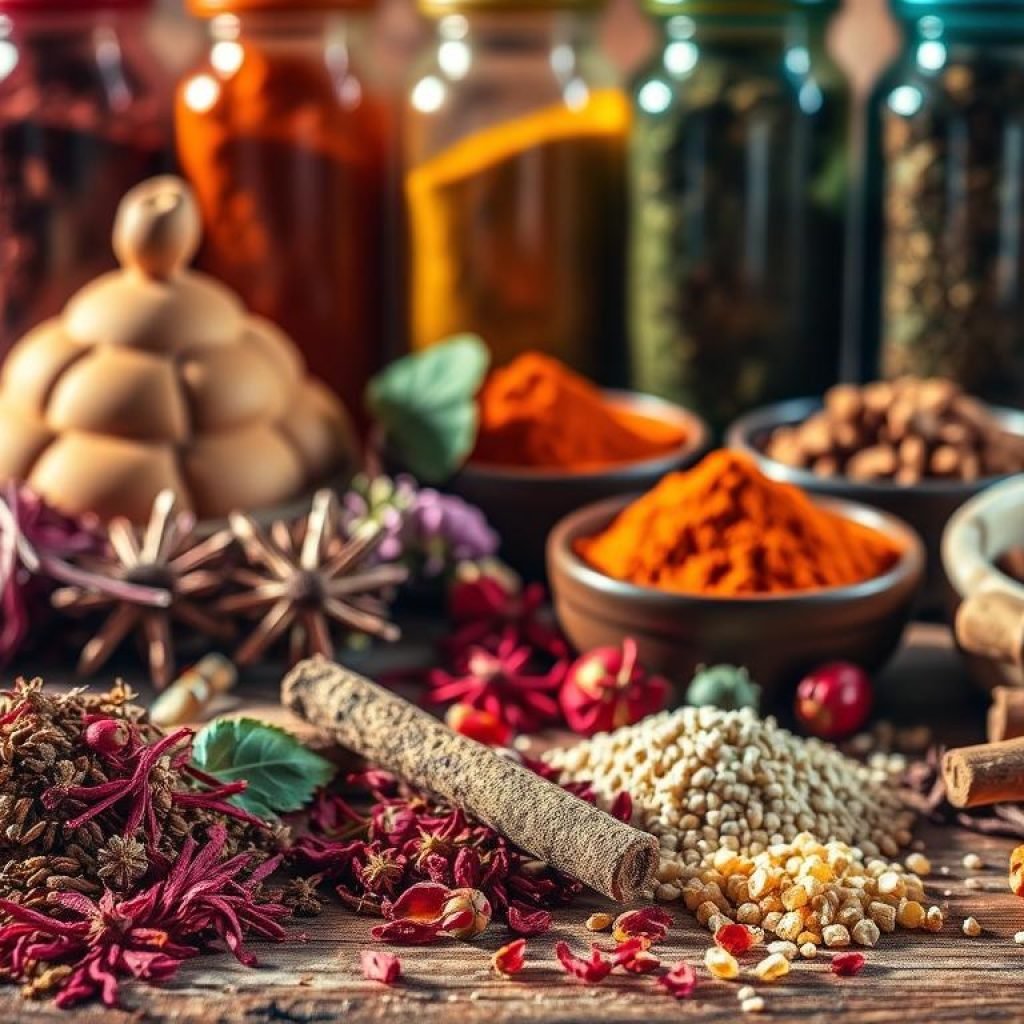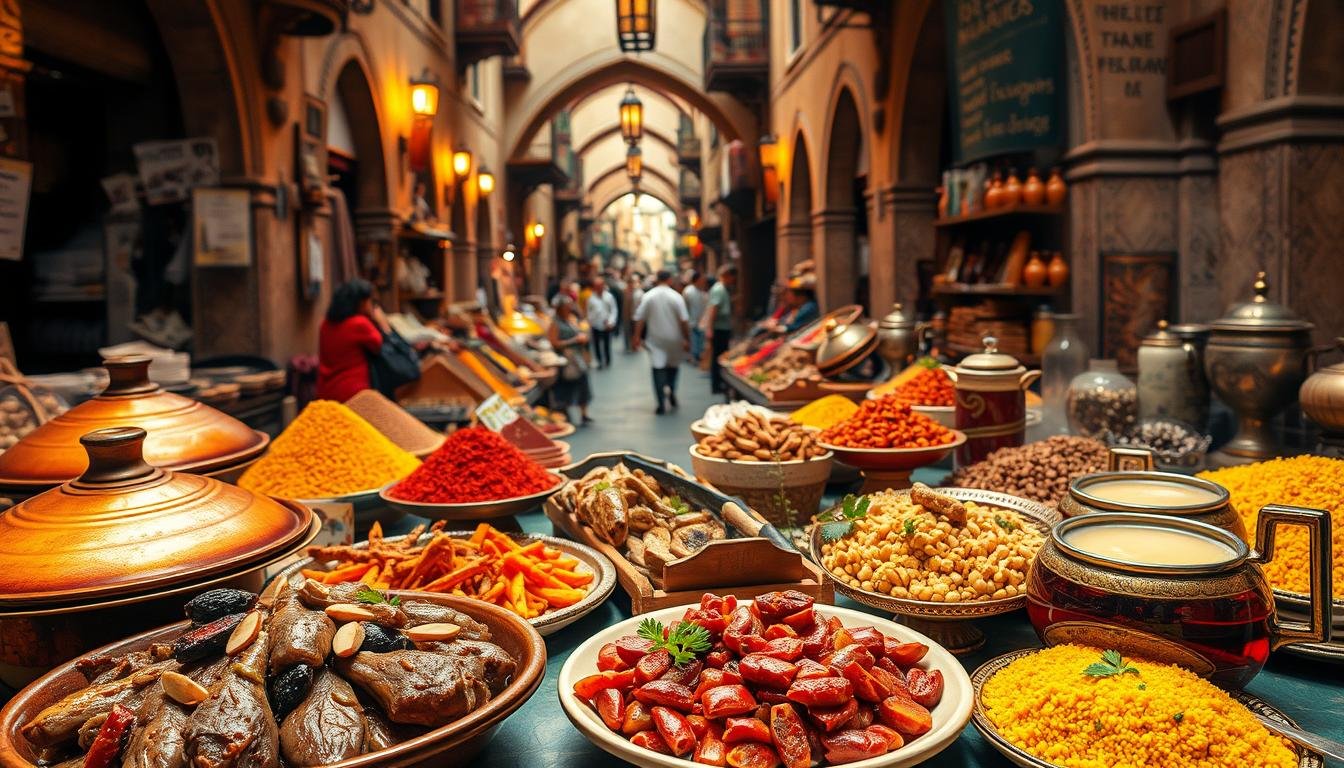What makes Morocco a paradise for foodies? How can you experience the best of traditional Moroccan cuisine? From Marrakech’s bustling streets to Fes’s historic city, Morocco offers a unique mix of flavors and cooking techniques. This Morocco food guide will show you the best dishes, like tagines and couscous, and the cultural importance of food in Morocco.
Introduction to Moroccan Cuisine
Moroccan cuisine is a blend of Arab, Berber, and Mediterranean cultures. It’s a fascinating topic to explore. Morocco is a top foodie destination, offering traditional dishes, street food, and luxury dining. This article will help you plan your culinary journey, whether you’re interested in learning about Moroccan dishes or need a comprehensive food guide.
Key Takeaways
- Moroccan cuisine is a unique blend of Arab, Berber, and Mediterranean influences
- Traditional Moroccan cuisine includes popular dishes like tagines, couscous, and harira
- Morocco is a top destination for foodies, with a wide range of street food and luxury dining experiences
- A Morocco food guide can help you navigate the country’s culinary scene and discover the best dishes in Morocco
- Understanding the cultural significance of food in Moroccan culture can enhance your travel experience
- From Marrakech to Fes, Morocco offers a wide range of culinary experiences, including cooking classes, food tours, and market visits
Discovering Moroccan Cuisine: An Overview
Moroccan cuisine is a mix of the country’s geography and culture. The coastal areas offer fresh seafood, while the Atlas Mountains are known for hearty tagines. Moroccan street food is a big part of the food scene, loved by both locals and tourists for its bold tastes and smells.
Exploring top Moroccan recipes means understanding the role of spices, especially ras el hanout. It brings depth to many dishes. Must-try foods include couscous, tagine, and harira soup. These dishes highlight Morocco’s culinary skills and cultural importance.
Street food in Morocco is a must-try. It offers everything from grilled corn to snail soup. Each dish shares a piece of Morocco’s rich food history. Trying new foods helps visitors understand Morocco’s mix of traditions and tastes.
Iconic Dishes to Try in Morocco
Moroccan food culture is a vibrant mix of history and geography. It combines authentic flavors and spices in a unique way. At its core are iconic dishes that highlight the country’s culinary heritage.
These dishes are not just tasty but also carry deep cultural meaning. Each region in Morocco has its own specialty. You can try everything from couscous to tagine and harira, each offering a different flavor experience.
Some of the most popular dishes include:
- Couscous: a traditional North African dish made from steamed semolina flour, often served with a variety of meats and vegetables
- Tagine: a slow-cooked stew made with meat, vegetables, and dried fruits, typically cooked in a clay pot with a conical lid
- Harira: a traditional soup made with lentils, chickpeas, tomatoes, and spices, often served as a starter or snack
These dishes showcase Morocco’s rich culinary landscape. They blend authentic flavors and spices, making you crave more. Trying couscous, tagine, or harira lets you dive into the heart of Moroccan food culture.

Moroccan cuisine is a unique blend of African, Arab, and European influences. It’s a true reflection of the country’s cultural diversity. Its iconic dishes are a must-try for any food lover.
Street Food Adventures in Morocco
Exploring Moroccan street food is a must for food lovers. The streets are filled with the smell of grilled meats, fresh fruits, and pastries. It’s a paradise for those who love trying new foods.
It’s important to be careful when trying street food. Look for vendors who keep their food and surroundings clean. This way, you can enjoy Morocco’s flavors safely. Some top street foods include grilled meats, fresh fruits, and traditional pastries.
Here are some tips for enjoying food from street vendors:
- Choose vendors with high standards of hygiene and food safety
- Try a variety of dishes to experience the full range of Moroccan street food
- Don’t be afraid to ask vendors about the ingredients and preparation methods
By following these tips, you can have a great time trying street food in Morocco. You’ll get to enjoy the best of Moroccan street food and the local cuisine.
Understanding Moroccan Spices and Ingredients
Traditional Moroccan cuisine is famous for its deep and complex flavors. These flavors come from the variety of Moroccan spices and ingredients used. Spices like cumin, coriander, cinnamon, and ginger create a unique blend in Moroccan dishes.
Some common spices in Moroccan cooking include:
- Cumin
- Coriander
- Cinnamon
- Ginger
- Turmeric
Unique ingredients like preserved lemons and argan oil also add special flavors. Preserved lemons are made by salting and fermenting lemons. This process gives them a sour and slightly sweet taste.
Knowing about Moroccan spices and ingredients is key to understanding Moroccan cuisine. With the right mix of spices and ingredients, anyone can make delicious Moroccan dishes.

Tea Culture: The Heart of Hospitality
Moroccan tea culture is a big part of the country’s welcoming traditions. Serving and drinking tea, especially mint tea, shows respect, friendship, and community. In Morocco, tea is a key part of social events and is served with meals.
The tea-making ritual, called atai, is done by the male head of the family. Moroccan tea is made with sugar and fresh mint. The way to make tea changes with the season and region. A frothy top on the tea means it’s made right, and pouring from high up creates this froth.
Tea is crucial in Moroccan hospitality. When guests come, they get mint tea as a welcome. This act is a big part of Moroccan culture. It helps start a connection with others.
- The use of green tea, specifically Chinese gunpowder tea
- The addition of fresh mint and sugar to the tea
- The importance of the tea pouring technique in creating a frothy surface
- The role of tea in traditional Moroccan hospitality and social gatherings
Moroccan tea culture is unique and interesting. It shows the country’s rich traditions and hospitality. By understanding tea’s role in Moroccan culture, visitors can learn more about the country’s heritage and welcoming nature.
Exploring Regional Variations in Moroccan Cuisine
Moroccan cuisine is a mix of Berber, Arab, Mediterranean, and African traditions. It’s fascinating to see how each region adds its own twist. From the fresh Moroccan seafood in the north to the hearty dishes in the Berber south, every area has its own flavors.
In the north, the coast is known for its seafood. Tangier is famous for its seafood tagines, slow-cooked with fish, shellfish, and spices. The south, however, is all about Berber cuisine. It uses traditional ingredients like couscous, meat, and vegetables.
- Tagine with seafood and preserved lemons
- Couscous with seven vegetables and meat
- Harira, a traditional soup made with lentils, chickpeas, and tomatoes
These dishes highlight the diversity of Moroccan cuisine. With its unique flavors and cooking methods, Morocco offers a wide range of culinary experiences. Whether you’re in the coastal areas, mountains, or cities, there’s always something new to try.
Dining Etiquette in Morocco
Understanding Moroccan dining etiquette is key to enjoying meals in Morocco. Mealtimes are sacred, and your table manners can greatly impact the atmosphere. The country’s rich culture is reflected in its dining traditions, and visitors should respect these.
Sharing food from a communal dish is a big part of Moroccan dining etiquette. About 75% of meals are served this way, with everyone gathering to share dishes. It’s also important to eat with your right hand, using your thumb and first two fingers. This is done by about 85% of Moroccans, and eating with your left hand is seen as impolite.
Other important traditional Moroccan dining practices include washing your hands before meals. This is often done with rose or orange-scented water. Also, don’t refuse food that’s offered to you. Around 60% of Moroccans believe refusing food is rude, so it’s best to accept graciously. By following these tips, you can have a positive and respectful dining experience in Morocco.
Here are some additional tips to keep in mind:
- Wait for the host to announce “Bismillah” before starting the meal
- Continue nibbling during meals to show appreciation for the food
- Avoid stopping eating abruptly, as this may lead others to stop eating as well
- Respect the elders at the table and follow their lead
Where to Eat: Recommended Restaurants
Finding the best restaurants in Morocco can be tough with so many choices. You can find traditional spots and modern places with new dishes. We’ve made a list of top places to eat in Marrakech and Fes.
For a real taste of Morocco, try restaurants known for their local dishes. Look for places that serve tagines, couscous, and harira. Don’t miss out on street food like brochettes and maakouda for authentic flavors.
- Dar Yacout, known for its set menu presented in a parade of giant tagines
- Le Jardin du Villa Maroc, offering a buffet lunch and transportation for approximately $30 per person
- Various seafood shacks along the waterfront outside the medina, serving fresh sardines, oysters, and shrimp
These spots will help you find the best Moroccan food. Morocco has a lively food scene with both old and new places to eat.
Exploring Morocco’s restaurants, try local dishes like seven vegetables couscous and ras el hanout. Moroccan food is rich and will impress you. Start planning your food trip to Morocco today.
Cooking Classes and Food Tours
Dive into Morocco’s rich culinary world with Moroccan cooking classes. Here, you can learn to make dishes like tagine and couscous. You’ll explore local markets, learn about key ingredients, and get the cooking skills that make Moroccan food special.
For a deeper dive, try food tours in Morocco. These tours let you discover the real tastes and smells of local food. You’ll visit secret spots, try street food, and meet locals. This way, you’ll understand how food is a big part of Moroccan culture.
Some top culinary experiences include cooking classes in Marrakech, Fez, and Essaouira. You’ll learn to make many traditional dishes, from tasty tagines to sweet pastries. Also, there are guided food walking tours in these cities. They let you see local markets, visit famous food stalls, and taste the freshest ingredients.
If you’re curious about Moroccan cuisine or just want to enjoy local flavors, Moroccan cooking classes and food tours in Morocco are great. They offer a mix of cultural learning, hands-on cooking, and delicious food. These culinary experiences will give you memories of Morocco that you’ll always treasure.
Exploring Moroccan Cuisine: Ingredients to Buy in Morocco
When you dive into Moroccan cuisine, you’ll find a world of flavors waiting to be explored. To cook authentic Moroccan dishes at home, it’s essential to know the key ingredients to buy in Morocco. These ingredients are the heart and soul of Moroccan cooking, and they will transport your taste buds to the vibrant streets of Marrakech.
One of the staples of Moroccan cuisine is olive oil. Moroccan olive oil is renowned for its rich and fruity flavors, making it the perfect choice for cooking and dressing salads. Look for high-quality olive oil from regions like Nador or Tafraout.
Another must-have ingredient is preserved lemons, known as “pickled lemons” or “limon amazigh.” These lemons are pickled in a mixture of salt, lemon juice, and spices, giving them a tangy and slightly sweet flavor. They add a burst of citrus to Moroccan dishes like stews, salads, and even couscous.
Spices are the backbone of Moroccan cuisine, and you’ll find a wide variety of them in Moroccan markets. Look for cumin, coriander, cinnamon, ginger, and turmeric. These spices are used to create the aromatic and complex flavors that define Moroccan cooking.
Don’t forget to pick up some preserved meats like merguez sausages and lamb. These meats are often used in Moroccan stews and tagines, adding a rich and savory flavor to the dishes.
For a touch of sweetness, try some dates. Moroccan dates are known for their natural sweetness and are often used in desserts like b’stilla, a flaky pastry filled with layers of meat, onions, and spices.
When it comes to grains, couscous is a staple in Moroccan cuisine. It’s a light and fluffy pasta made from semolina flour, and it’s often served with a variety of stews and sauces.
Finally, don’t miss out on the Moroccan spices and seasonings. These include ras el hanout, a blend of spices that can vary depending on the region, and preserved spices like preserved garlic and preserved ginger. These spices add depth and complexity to Moroccan dishes.
By incorporating these ingredients into your Moroccan recipes, you’ll be able to create authentic and delicious dishes that will transport your taste buds to the vibrant streets of Morocco.
Key Ingredients to Buy in Morocco:
- Olive oil
- Preserved lemons
- Spices (cumin, coriander, cinnamon, ginger, turmeric)
- Preserved meats (merguez sausages, lamb)
- Dates
- Couscous
- Spices and seasonings (ras el hanout, preserved garlic, preserved ginger)




Comment (0)